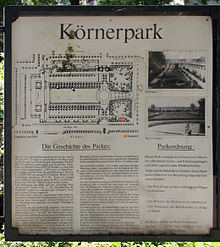
The Orangery Palace is a palace located in the Sanssouci Park of Potsdam, Germany. It is also known as the New Orangery on the Klausberg, or just the Orangery. It was built on behest of the "Romantic on the Throne", King Friedrich Wilhelm IV from 1851 to 1864.
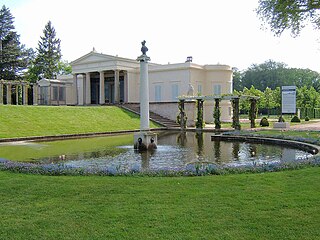
Charlottenhof Palace or Charlottenhof Manor is a former royal palace located southwest of Sanssouci Palace in Sanssouci Park at Potsdam, Germany. It is best known as the summer residence of Crown Prince Frederick William. Today it is maintained by the Prussian Palaces and Gardens Foundation Berlin-Brandenburg.
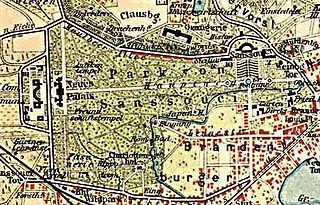
Sanssouci Park is a large park surrounding Sanssouci Palace in Potsdam, Germany, built under Frederick the Great in the mid-18th century. Following the terracing of the vineyard and the completion of the palace, the surroundings were included in the structure. A Baroque flower garden with lawns, flower beds, hedges and trees was created. In the hedge quarter 3,000 fruit trees were planted. The greenhouses of the numerous nurseries contained oranges, melons, peaches and bananas. The goddesses Flora and Pomona, who decorate the entrance obelisk at the eastern park exit, were placed there to highlight the connection of a flower, fruit and vegetable garden. Along with the Sanssouci Palace and other nearby palaces and parks, Sanssouci Park was inscribed on the UNESCO World Heritage List in 1990 for its unique architectural unity and testimony to 18th and 19th century landscaping in Europe.
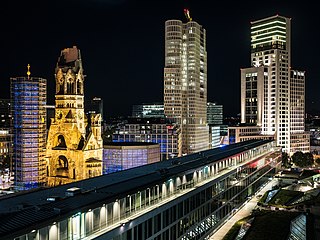
Breitscheidplatz is a major public square in the inner city of Berlin, Germany. Together with the Kurfürstendamm boulevard, it marks the centre of former West Berlin and the present-day City West. It is named after Rudolf Breitscheid.

Weikersheim Palace is a palace in Weikersheim, Baden-Württemberg, Germany. It was a medieval seat and later a Renaissance residence of the princely House of Hohenlohe.

The Britzer Garten is a large park in Berlin, named after Britz, a neighborhood of the borough of Neukölln. It was constructed for the Bundesgartenschau 1985, in order to provide a new landscape park to the citizens in the southeast of West-Berlin, who were at that time cut off from the surrounding countryside.

The Schloss Britz is the former manor-house of the historical Rittergut and village Britz, now a district of Berlin-Neukölln. Today it is the headquarters of the cultural organization Kulturstiftung Schloss Britz and includes authentic reconstructed rooms from around 1880. The house is a museum demonstrating interiors of the Gründerzeit era. The manorial park is also well preserved with its mature trees and its 1890s system of trails. In 1997 the park was honored with the German Gustav Meyer Prize for the accuracy and historic authenticity of the reconstruction.

Bergpark Wilhelmshöhe is a landscape park in Kassel, Germany. The area of the park is 2.4 square kilometres, making it the largest European hillside park, and second largest park on a hill slope in the world. Construction of the Bergpark, or "mountain park", began in 1689 at the behest of the Landgraves of Hesse-Kassel and took about 150 years. The park is open to the public today. Since 2013, it has been a UNESCO World Heritage Site because of its monumental Baroque architecture and its unique fountains and water features.

Neukölln, from 1899 to 1920 an independent city, is a large inner-city quarter (Ortsteil) of Berlin in the homonymous borough (Bezirk) of Neukölln, including the historic village of Rixdorf and numerous Gründerzeit estates. With 163,735 inhabitants (2024) the quarter is the second-most densely populated of Berlin after Prenzlauer Berg. Since the early 13th century, the local settlements, villages and cities until present-day Neukölln have always been a popular destination for colonists and immigrants. In modern times, it was originally characterized by mostly working-class inhabitants, but western immigration since the turn of the millennium has led to gentrification.

The Flora und Botanischer Garten Köln is a municipal formal park and botanical garden located adjacent to Cologne Zoological Garden at Amsterdamer Straße 34, Cologne, North Rhine-Westphalia, Germany. It is open daily without charge.

Gaussig House is a manor house in Palladian style located in the district Bautzen in the German state of Saxony approximately 6 km southwest from the Upper Lusatian central city Bautzen. Extending over some 75 acres (300,000 m2), nestled in beautiful natural surroundings and bordered by the Grosse Picho hill to the south, lies one of Upper Lusatia’s largest landscape parks. Gaussig House, the orangery, the church and vicarage, and the estate form the centre of Gaussig village.

Pillnitz Palace is a restored Baroque castle at the eastern end of the city of Dresden in the German state of Saxony. It is located on the right bank of the River Elbe in the former village of Pillnitz. It was the summer residence of many electors and kings of Saxony; it is also known for the Declaration of Pillnitz in 1791.
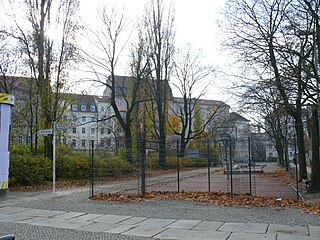
The Ackerstraße is a street in Berlin which runs northwest from near the Liesenstraße – Scheringstraße traffic circle in Gesundbrunnen to Invalidenstraße, where it turns south, terminating at the Linienstraße in Mitte.

Köllnischer Park is a public park located near the River Spree in Mitte, Berlin. It is named after Cölln, one of the two cities which came together to form Berlin; the park location was originally just outside it. Approximately 1 hectare in area, the park came into existence in the 18th and 19th centuries on the site of fortifications. It was redesigned as a public park in 1869–1873 and was further modified in the 20th century with the addition of first a bear enclosure, the Bärenzwinger, and later a permanent exhibition of sculpture, the Lapidary. The park is a registered Berlin landmark.
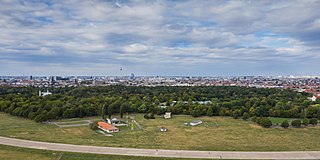
The Volkspark Hasenheide is a park of around fifty hectares in the Berlin district of Neukölln on the border with Kreuzberg. The name of the park goes back to the use of the area as a rabbit enclosure from 1678. The Great Elector, Frederick William hunted there.
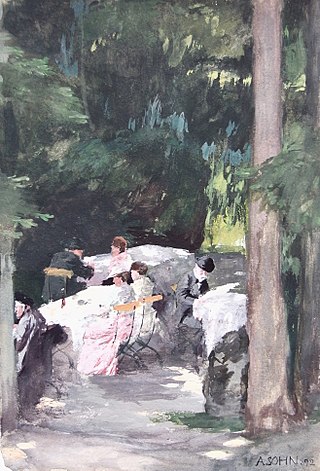
The Malkastenpark is a historic private park, now in the centre of Düsseldorf, North Rhine-Westphalia, Germany. The name refers to a group of artists, Malkasten, founded in 1848. The park is also known as the Jacobigarten, after the original owners who created a Baroque garden. It is now a public garden with both Baroque features and English landscape garden elements, and a listed historic monument.

The Promenadenring Leipzig is the oldest municipal landscape park in Germany and one of the most important garden and cultural monuments in the city. The term is also used as a synonym for Leipzig's inner city ring road, a traffic facility that is connected to the green spaces of the Promenadenring. Like the inner city ring road, the promenade ring is about 3.6 kilometers long (2.24 mi.).

Hermannplatz, located in the northern part of the Berlin district of Neukölln, is a town square named on 9 September 1885. The name is similar to Hermannstraße and refers to Hermann the Cheruscan, although there is a belief that it was named after the Rixdorf community leader Hermann Boddin. Only Karstadt department store section belongs to the Friedrichshain-Kreuzberg district; the rest of the plaza is owned by Neukölln. As Kreuzberg's most southeastern point, the square is still regarded as the gateway to Neukölln.

The Favorite Palace on the banks of the Rhine in Mainz was a significant Baroque palace complex in the Electorate of Mainz, featuring elaborate gardens and water features. The Favorite was built in several stages, starting in the year 1700. It was essentially completed around the year 1722. Its patron, Lothar Franz von Schönborn (1655–1729), Prince-elector of Mainz and Prince-Bishop of Bamberg, came from one of the most prominent Franconian-Middle Rhine noble families of the time, the Schönborn family, and was the patron of many Baroque gardens and palaces. The Lustschloss Favorite was completely destroyed during the Siege of Mainz in 1793 in the French Revolutionary Wars.

